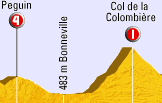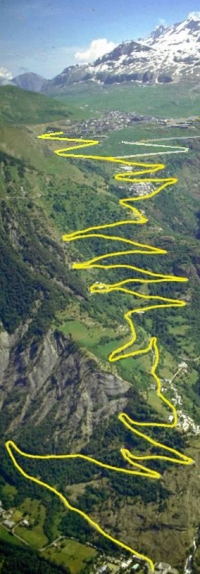
|
|
|
FIVE MYTHS ABOUT THE MOUNTAINS OF THE TOUR DE FRANCE The mountain of the Tour de France are almost mythical. And that's just fine. But certain myths don't hold water. Danskebjerge.dk will here take a closer look at some of them. Please note: The below article has not been updated since 2010. To see an updated analysis of the Tour climbs, check out this page from 2015.
ANSWER: That's too general. There are five categories in Tour de France: from Category 4 and up "beyond category", in French: "Hors Catégorie". Of course, the level of difficulty is increased, as you move up through the categories - generally speaking. But a climb in the easy Category 4 may very well be steeper than, for instance, a climb in Category 3 or 2. There is huge variation in the type of climbs within each category and thus a considerable overlap between the categories. As a curiosity, it can be mentioned that the Category 2 climbs in average are a bit flatter than the Category 3 climbs.
ANSWER: Wrong. In the Tour de France, we've seen Category 4 climbs which could be surpassed by Danish climbs in length as well as steepness. But the only Danish climb matching the average for both length and steepness in Category 4 is Jellingvej in the city of Vejle.
ANSWER: Hardly correct. Many believe the routes of the Giro d'Italia and the Vuelta are tougher. And accordingly, Italy and Spain have many of the really big climbs. The database at Salite.ch, which has registered the biggest climbs in Europe, shows among others things that the two countries have more climbs with a height gain of over 2000 meters than France. Besides, a race such as the Giro regularly includes the climb Mortirolo which has an average gradient of more than 10 percent. Lance Armstrong has said that it's the toughest climb he has ever ridden.
ANSWER: Not at all. As to steepness and length, Alpe d'Huez is found pretty far down the list of European climbs ("only" about 7.7% through 14,2 kilometers). But it's a very fine climb, and in time it has become legendary, especially because it is so often placed at the end of a stage. And that position is exactly what gives Alpe d'Huez its traditional "beyond category" status. Under other circumstances it could be categorized as a Category 1 climbs.
ANSWER: Only true in part. Yes, among the front riders a harsh climb can cause a few changes in the overall classification. But if you want to win the whole race, you must be a good allround rider who manages to stay in the front in all stages. Rarely do we see riders jump from a position in the lower half of the field all the way up to the top, just because of good efforts on one or two mountain stages. Also, it rarely occurs that a rider wins the Tour solely by means of great "raids" over several mountains. Thus we need to go all the way back to 1970 in order to find a rider winning both the King of the Mountains jersey and the overall classification (Eddie Merckx). By the way: the field often passes big climbs in one group - that's mainly climbs which are placed some distance before the finish line, and which therefore have minimal effect on the race. Related articles: Analysis of the Tour climbs Denmark's most wicked climbs |

